Students who are in search of 11th Bio Botany exam can download this Tamilnadu State Board Solutions for 11th Bio Botany Chapter 9 Tissue and Tissue System from here for free of cost. These cover all Chapter 9 Tissue and Tissue System Questions and Answers, PDF, Notes, Summary. Download the Samacheer Kalvi 11th Biology Book Solutions Questions and Answers by accessing the links provided here and ace up your preparation.
Tamilnadu Samacheer Kalvi 11th Bio Botany Solutions Chapter 9 Tissue and Tissue System
Kickstart your preparation by using this Tamilnadu State Board Solutions for 11th Bio Botany Chapter 9 Tissue and Tissue System Questions and Answers get the max score in the exams. You can cover all the topics of Chapter 9 Tissue and Tissue System Questions and Answers easily after studying the Tamilnadu State Board 11th Bio Botany Textbook solutions pdf.
Samacheer Kalvi 11th Bio Botany Tissue and Tissue System Text Book Back Questions and Answers
Question 1.
Refer to the given figure and select the correct statement:
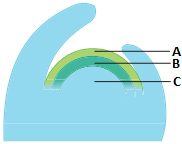
(i) A, B, and C are histogen of shoot apex
(ii) A Gives rise to medullary rays
(iii) B Gives rise to cortex
(iv) C Gives rise to epidermis
(a) (i) and (ii) only
(b) (ii) and (in) only
(c) (i) and (iii) only
(d) (iii) and (iv) only
Answer:
(c) (i) and (iii) only
Question 2.
Read the following sentences and identify the correctly matched sentences.
(i) In exarch condition, the protoxylem lies outside of metaxylem.
(ii) In endarch condition, the protoxylem lie towards the centre.
(iii) In centarch condition, metaxylem lies in the middle of the protoxylem.
(iv) In mesarch condition, protoxylem lies in the middle of the metaxylem.
(a) (i), (ii) and (iii) only
(b) (ii), (iii) and (iv) only
(c) (i), (ii) and (iv) only
(d) All of these
Answer:
(c) (i), (ii) and (iv) only
Question 3.
In Gymnosperms, the activity of sieve tubes are controlled by:
(a) Nearby sieve tube members.
(b) Phloem parenchyma cells.
(c) Nucleus of companion cells.
(d) Nucleus of albuminous cells.
Answer:
(c) Nucleus of companion cells.
Question 4.
When a leaf trace extends from a vascular bundle in a dicot stem, what would be the arrangement of vascular tissues in the veins of the leaf?
(a) Xylem would be on top and the phloem on the bottom
(b) Phloem would be on top and the xylem on the bottom
(c) Xylem would encircle the phloem
(d) Phloem would encircle the xylem
Answer:
(a) Xylem would be on top and the phloem on the bottom
Question 5.
Grafting is successful in dicots but not in monocots because the dicots have:
(a) vascular bundles arranged in a ring
(b) cambium for secondary growth
(c) vessels with elements arranged end to end
(d) cork cambium
Answer:
(b) cambium for secondary growth
Question 6.
Why the cells of sclerenchyma and tracheids become dead?
Answer:
The cells of sclerenchyma and tracheids become dead because they lack protoplasm.
Question 7.
Explain sclereids with their types.
Answer:
Sclereids are dead cells, usually these are isodiametric but some are elongated too. The cell wall is very thick due to lignification. Lumen is very much reduced. The pits may simple or branched. Sclereids are mechanical in function. They give hard texture to the seed coats, endosperms etc., Sclereids are classified into the following types.
- Branchysclereids or Stone cells: Isodiametric sclereids, with hard cell wall. It is found in bark, pith cortex, hard endosperm and fleshy portion of some fruits. eg: Pulp of Pyrus.
- Macrosclereids: Elongated and rod shaped cells, found in the outer seed coat of leguminous plants. eg: Crotalaria and Pisum sativum.
- Osteosclereids (Bone cells): Rod shaped with dilated ends. They occur in leaves and seed coats. eg: seed coat of Pisum and Hakea.
- Astrosclereids: Star cells with lobes or arms diverging form a central body. They occur in petioles and leaves. eg: Tea, Nymphae and Trochodendron.
- Trichosclereids: Hair like thin walled sclereids. Numerous small angular crystals are embedded in the wall of these sclereids, present in stems and leaves of hydrophytes. eg: Nymphaea leaf and Aerial roots of Monstera
Question 8.
What are sieve tubes? Explain.
Answer:
Sieve tubes are long tube like conducting elements in the phloem. These are formed from a series of cells called sieve tube elements. The sieve tube elements are arranged one above the other and form vertical sieve tube. The end wall contains a number of pores and it looks like a sieve. So it is called as sieve plate. The sieve elements show nacreous thickenings on their lateral walls. They may possess simple or compound sieve plates.
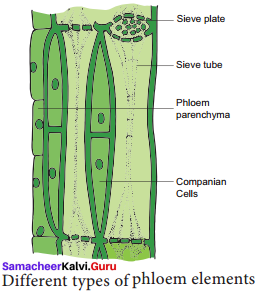
The function of sieve tubes are believed to be controlled by campanion cells In mature sieve tube, Nucleus is absent. It contains a lining layer of cytoplasm. A special protein (P. Protein = Phloem Protein) called slime body is seen in it. In mature sieve tubes, the pores in the sieve plate are blocked by a substance called callose (callose plug). The conduction of food material takes lace through cytoplasmic strands. Sieve tubes occur only in Angiosperms.
Question 9.
Distinguish the anatomy of dicot root from monocot root.
Answer:
The anatomy of dicot root from monocot root:
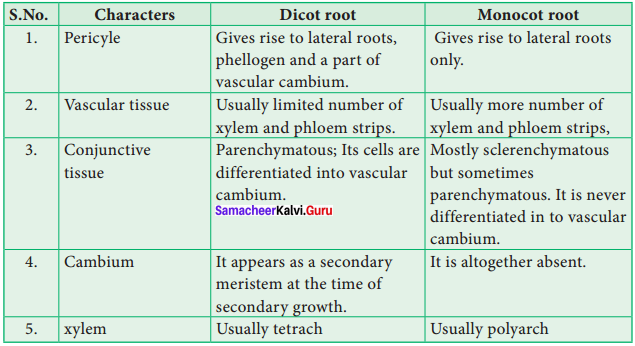
Question 10.
Distinguish the anatomy of dicot stem from monocot stem.
Answer:
The anatomy of dicot stem from monocot stem:
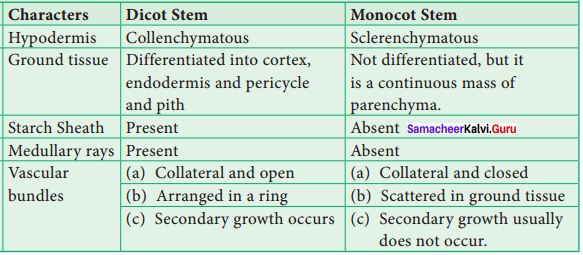
Samacheer Kalvi 11th Bio Botany Tissue and Tissue System Other Important Questions & Answers
I. Choose the correct answer. (1 Mark)
Question 1.
Who is the father of plant anatomy?
(a) David Muller
(b) Katherine Esau
(c) Nehemiah Grew
(d) Hofmeister
Answer:
(c) Nehemiah Grew
Question 2.
The study of internal structure and organisation of plant is called:
(a) plant taxonomy
(b) plant anatomy
(c) plant physiology
(d) plant ecology
Answer:
(b) plant anatomy
Question 3.
The book “Anatomy of seed plants” is written by:
(a) Hanstein
(b) Schmidt
(c) Nicholsen
(d) Katherine Esau
Answer:
(d) Katherine Esau
Question 4.
The term meristem is coined by:
(a) Nageli
(b) Robert
(c) Stevers
(d) Clowes
Answer:
(a) Nageli
Question 5.
Which of the statement is not correct?
(a) Meristematic cells are self perpetuating
(b) Meristematic cells are most actively dividing cells
(c) Meristematic cells have large vacuoles
(d) Meristematic cells have dense cytoplasm with prominent nucleus
Answer:
(c) Meristematic cells have large vacuoles
Question 6.
Apical cell theory is proposed by:
(a) David brown
(b) Hofmeister
(c) Land mark
(d) Clowes
Answer:
(b) Hofmeister
Question 7.
The tunica is:
(a) the peripheral zone of shoot apex, that forms cortex
(b) the inner zone of shoot apex, that forms stele
(c) the peripheral zone of shoot apex, that forms epidermis
(d) the inner zone of shoot apex, that forms cortex and stele
Answer:
(c) the peripheral zone of shoot apex, that forms epidermis
Question 8.
Which of the histogens gives rise to root cap?
(a) Plerome
(b) Periblem
(c) Dermatogen
(d) Calyptrogen
Answer:
(d) Calyptrogen
Question 9.
Quiescent centre concept was proposed by:
(a) Lindall
(b) Clowes
(c) Holstein
(d) Sanio
Answer:
(b) Clowes
Question 10.
Parenchyma cells which stores resin, tannins, calcium carbonate and calcium oxalate are termed as:
(a) critoblast
(b) chromoblasts
(c) idioblasts
(d) astroblasts
Answer:
(c) idioblasts
Question 11.
Petioles of banana is composed of:
(a) storage parenchyma
(b) stellate parenchyma
(c) angular collenchyma
(d) prosenchyma
Answer:
(b) stellate parenchyma
Question 12.
Which of the following statement is not correct?
(a) Sclerenchyma is a dead cell
(b) It lacks protoplasm
(c) The cell walls of these cells are uniformly thickened
(d) Sclerenchyma are actively dividing cells
Answer:
(d) Sclerenchyma are actively dividing cells
Question 13.
The seed coat of ground nut is made up of:
(a) stone cells
(b) osteosclereids
(c) macrosclereids
(d) parenchyma cells
Answer:
(b) osteosclereids
Question 14.
Plant fibers are modified:
(a) sclerenchyma cells
(b) collenchyma cells
(c) parenchyma cells
(d) none of the above
Answer:
(a) sclerenchyma cells
Question 15.
The term xylem was introduced by:
(a) Alexander
(b) Nageli
(c) Holstein
(d) Schemidt
Answer:
(b) Nageli
Question 16.
What type of xylem arrangement is seen in Selaginella sp?
(a) Endarch
(b) Exarch
(c) Centrarch
(d) Mesarch
Answer:
(c) Centrarch
Question 17.
In cross section, the tracheids are:
(a) hexagonal in shape
(b) rectangular in shape
(c) triangular in shape
(d) polygonal in shape
Answer:
(d) polygonal in shape
Question 18.
In grasses the guard cells in stoma are:
(a) bean shaped
(b) irregular shaped
(c) dumbbell shaped
(d) bell shaped
Answer:
(c) dumbbell shaped
Question 19.
Bulliform cells are present in:
(a) mango
(b) grasses
(c) ground nut
(d) potato
Answer:
(b) grasses
Question 20.
The sunken stomata:
(a) reduce water loss by transpiration
(b) increase water loss by transpiration
(c) increase heat loss by evaporation
(d) neither reduce nor increase water loss by transpiration
Answer:
(a) reduce water loss by transpiration
Question 21.
In Ocimum the trichomes are:
(a) non – glandular
(b) fibrous
(c) glandular
(d) none of these
Answer:
(c) glandular
Question 22.
In dicot stem, the hypodermis is generally:
(a) parenchymatous
(b) sclerenchymatous
(c) collenchymatous
(d) none of these
Answer:
(c) collenchymatous
Question 23.
Casparian strips contain thickenings of:
(a) calcium carbonate and calcium oxalate
(b) carbohydrate, protein and lignin
(c) crystal of calcium oxalate
(d) lignin, suberin and some other carbohydrates
Answer:
(d) lignin, suberin and some other carbohydrates
Question 24.
Indicate the correct statement:
(a) Albuminous cells in gymnosperms are a nucleated parenchyma cells.
(b) Albuminous cells in gymnosperms are nucleated collenchyma cells.
(c) Albuminous cells in gymnosperms are nucleated, thin walled parenchyma cells.
(d) Albuminous cells in gymnosperms are a nucleated sclerenchyma cells.
Answer:
(c) Albuminous cells in gymnosperms are nucleated, thin walled parenchyma cells.
Question 25.
Secondary phloem is derived from:
(a) apical meritesm
(b) vascular cambium
(c) primary phloem
(d) none of the above
Answer:
(b) vascular cambium
Question 26.
Which of the following statement is not correct?
(a) The outer most layer of the root is called piliferous layer.
(b) The chief function of piliferous layer is protection.
(c) Piliferous layer is made up of parenchyma cells with intracellular space.
(d) Piliferous layer is made up of parenchyma cells without intracellular space.
Answer:
(d) Piliferous layer is made up of parenchyma cells without intracellular space.
Question 27.
In beans, the metaxylem vessels are generally:
(a) polygonal in shape
(b) circular in shape
(d) rectangular in shape
(d) triangular in shape
Answer:
(a) polygonal in shape
Question 28.
Who discovered the Annular collenchyma?
(a) Clowes
(b) Sanio
(c) Nageli
(d) Duchaigne
Answer:
(d) Duchaigne
Question 29.
The main function of xylem is:
(a) to conduct the minerals to various parts of plants
(b) to conduct oxygen to various parts of plant body
(c) to conduct water and minerals from root to the other parts of the plant body
(d) to conduct stored food to various parts of plant body
Answer:
(c) to conduct water and minerals from root to the other parts of the plant body
Question 30.
In maize the vascular bundles are:
(a) scattered
(b) concentric
(c) excentric
(d) radial
Answer:
(a) scattered
Question 31.
stomata in leaves of a plant are used for:
(a) transpiration
(b) transpiration and gas exchange
(c) gas exchange
(d) none of the above
Answer:
(b) transpiration and gas exchange
Question 32.
Which of the statement is not correct?
(a) Palisade parenchyma cells are seen beneath the upper epidermis
(b) Palisade parenchyma cells contain more chloroplasts
(c) Palisade parenchyma cells are irregularly shaped
(d) The function of palisade parenchyma is photosynthesis
Answer:
(c) Palisade parenchyma cells are irregularly shaped
Question 33.
Spongy parenchyma cells are:
(a) irregularly shaped
(b) elongated cylindrical cells
(c) very lightly arranged cells
(d) with more number of chloroplasts than palisade parenchyma
Answer:
(a) irregularly shaped
Question 34.
The main function of spongy parenchyma is:
(a) photosynthesis
(b) exchange of gases
(c) exchange of minerals
(d) water transport
Answer:
(b) exchange of gases
Question 35.
All mesophyll cells in monocot leaf are nearly:
(a) isodiametric and thick walled
(b) irregular and thick walled
(c) isodiametric and thin walled
(d) irregular and thin willed
Answer:
(c) isodiametric and thin walled
Question 36.
Structurally, hydathodes are modified:
(a) cambium tissue
(b) parenchyma
(c) pith
(d) stomata
Answer:
(d) stomata
Question 37.
Hydathodes occurs in the leaves of:
(a) desert plants
(b) submerged aquatic plants
(c) floating aquatic weeds
(d) forest trees
Answer:
(b) submerged aquatic plants
Question 38.
The process of guttation is seen in:
(a) grasses
(b) dicot plants
(c) desert plants
(d) Nerium
Answer:
(a) grasses
Question 39.
Salt glands are present in:
(a) xerophytes
(b) hydrophytes
(c) halophytes
(d) merophytes
Answer:
(c) halophytes
Question 40.
The term sieve tubes is coined by:
(a) Schleiden
(b) Hanstein
(c) Tsehireh
(d) Hartig
Answer:
(d) Hartig
II. Answer the following. (2 Marks)
Question 1.
Define the tissue?
Answer:
A tissue is a group of cells that are alike in origin, structure and function. The study of tissue is called Histology.
Question 2. What are the different types of plant tissue?
Answer:
The two types of principal groups are:
- Meristematic tissues
- Permanent tissues.
Question 3.
Mention any, two characters of meriste – matic tissue.
Answer:
Two characters of meriste – matic tissue:
- The meristematic cells are isodiametric and they may be, oval, spherical or polygonal in shape.
- They have generally dense cytoplasm with prominent nucleus.
Question 4.
Mention the function of apical meristem.
Answer:
Present in apices of root and shoot. It is responsible for increase in the length of the plant, it is called as primary growth.
Question 5.
What is mean by carpus?
Answer:
It is the inner zone of shoot apex,that forms cortex and stele of shoot.
Question 6.
Explain apical cell theory?
Answer:
Apical cell theory is proposed by Nageli. The single apical cell or apical initial composes the root meristem. The apical initial is tetrahedral in shape and produces root cap from one side. The remaining three sides produce epidermis, cortex and vascular tissues. It is found in vascular cryptogams.
Question 7.
What is meant by angular collenchyma?
Answer:
It is the most common type of collenchyma with irregular arrangement and thickening at the angles where cells meet., eg: Hypodermis of Datum and Nicotiana.
Question 8.
Explain briefly Branchysciereids or Stone cells.
Answer:
Isodiametric sclereids, with hard cell wall. It is found in bark, pith cortex, hard endosperm and fleshy portion of some fruits. eg: Pulp of Pyrus.
Question 9.
What is Filiform Sclereids?
Answer:
The sclereids are present in the leaf lamina of Olea europaea. They are very much elongated fibre like and about 1mm length.
Question 10.
Distinguish between Libriform fibres and Fibre tracheids.
Answer:
Between Libriform fibres and Fibre tracheids:
| Libriform fibres |
Fibre tracheids |
| 1. These fibres have slightly lignified secondary walls with simple pits. These fibres are long and narrow. | 1. These are shorter than the libriform fibres with moderate secondary thickenings in the cell walls. Pits are simple or bordered. |
Question 11.
What are bast fibres?
Answer:
These fibres are present in the phloem. Natural Bast fibres are strong and cellulosic. Fibres obtaining from the phloem or outer bark of jute, kenaf, flax and hemp plants. The so called pericyclic fibres are actually phloem fibres.
Question 12.
What is meant by endarch type of xylem arrangements?
Answer:
Protoxylem lies towards the .centre and meta xylem towards the periphery this condition is called Endarch. It is seen in stems.
Question 13.
What are the types of cells present in phloem?
Answer:
Phloem consists of four types of Cells:
- Sieve elements
- Companion cells
- Phloem parenchyma
- Phloem fibres.
Question 14.
Define epiblema?
Answer:
It is made up of single layer of parenchyma cells which are arranged compactly without intercellular spaces. It is devoid of epidermal pores and cuticle. Root hair is always single celled, it absorbs water and mineral salts from the soil. The another important function of piliferous layer is protection.
Question 15.
Explain bulliform cells in grasses.
Answer:
Some cells of upper epidermis (eg: Grasses) are larger and thin walled. They are called bulliform cells or motor cells. These cells are helpful for the rolling and unrolling of the leaf according to the weather change.
Question 16.
What is meant by Sunken Stomata?
Answer:
In some Xerophytic plants (eg: Cycas, Nerium), stomata is sunken beneath the abaxial leaf surface within stomatal crypts. The sunken stomata reduce water loss by transpiration.
Question 1 7.
Mention any two functions of epidermal tissue system in plants.
Answer:
Two functions of epidermal tissue system in plants:
- This system in the shoot checks excessive loss of water due to the presence of cuticle.
- Epidermis protects the underlying tissues.
Question 18.
Define chlorenchymo?
Answer:
Sometimes in young stem, chloroplasts develop in peripheral cortical cells, which is Called chlorenchyma.
Question 19.
What is meant by casparian strips?
Answer:
In true root endodermis, radial and inner tangential walls of endodermal cells possess thickenings of lignin, suberin and some other carbohydrates in the form of strips they are called casparian strips.
Question 20.
What are albuminous cells?
Answer:
The cytoplasmic nucleated parenchyma, is associated with the sieve cells of Gymnosperms. Albuminous cells in Conifers are analogous to companion cells of Angiosperms. It also called as strasburger cells.
Question 21.
Describe briefly radial types of vascular Bundles.
Answer:
Xylem and phloem are present on different radii alternating with each other. The bundles are separated by parenchymatous tissue. (Monocot and Dicot roots).
Question 22.
Define stele?
Answer:
All the tissues inside the endodermis comprise the stele. This includes pericycle, vascular system and pith.
Question 23.
What is meant by cambium?
Answer:
Cambium consists of brick shaped and thin walled meristematic cells. It is one to four layers in thickness. These cells are capable of forming new cells during secondary growth.
Question 24.
Define silica Cells?
Answer:
Some of the epidermal cells of the grass are filled with silica. They are called silica cells.
Question 25.
Define, hydathode?
Answer:
A hydathode is a type of epidermal pore, commonly found in higher plants. Structurally, hydathodes are modified stomata, usually located at leaf tips or margins, especially at the teeth. Hydathodes occur in the leaves of submerged aquatic plants such as ranunculus fluitans as well as in many herbaceous land plants.
III. Answer the following. (3 Marks)
Question 1.
Explain apical cell theory.
Answer:
Apical cell theory is proposed by Hofmeister (1852) and supported by Nageli (1859). A single apical cell is the structural and functional unit. This apical cell governs the growth and development of whole plant body. It is applicable in Algae, Bryophytes and in some Pteridophytes.
Question 2.
Explain histogen theory.
Answer:
Histogen theory is proposed by Hanstein (1868) and supported by Strassburgur. The shoot apex comprises three distinct zones.
- Dermatogen: It is a outermost layer. It gives rise to epidermis.
- Periblem: It is a middle layer. It gives rise to cortex.
- Plerome: It is innermost layer. It gives rise to stele.
Question 3.
What is meant by quiescent centre concept?
Answer:
Quiescent centre concept was proposed by Clowes (1961) to explain root apical meristem activity. These centre is located between root cap and differentiating cells of the roots. The apparently inactive region of cells in root promeristem is called quiescent centre. It is the site of hormone synthesis and also the ultimate source of all meristematic cells of the meristem.
Question 4.
Explain the term “sclereids”.
Answer:
Sclereids are dead cells, usually these are isodiametric but some are elongated too. The cell wall is very thick due to lignification. Lumen is very much reduced. The pits may simple or branched. Sclereids are mechanical in function. They give hard texture to the seed coats, endosperms etc.
Question 5.
Explain briefly about plant fibres.
Answer:
Fibres are very much elongated sclerenchyma cells with pointed tips. Fibres are dead cells and have lignified walls with narrow lumen. They have simple pits. They provide mechanical strength and protect them from the strong wind. It is also called supporting tissues. Fibres have a great commercial value in cottage and textile industries.
Question 6.
Write briefly about xylem fibres.
Answer:
The fibres of sclerenchyma associated with the xylem are known as xylem fibres. Xylem fibres are dead cells and have lignified walls with narrow lumen. They cannot conduct water but being stronger provide mechanical strength. They are present in both primary and secondary xylem. Xylem fibres are also called libriform fibres.
The fibres are abundantly found in many plants. They occur in patches, in continuous bands and sometimes singly among other cells. Between fibres and normal tracheids, there are many transitional forms which are neither typical fibres nor typical tracheids. The transitional types are designated as fibre – tracheids. The pits of fibre – tracheids are smaller than those of vessels and typical tracheids.
Question 7.
Explain companion cells.
Answer:
The thin walled, elongated, specialized parenchyma cells, which are associated with die sieve elements, are called companion cells. These cells are living and they have cytoplasm and a prominent nucleus. They are connected to the sieve tubes through pits found in the lateral walls. Through these pits cytoplasmic connections are maintained between these elements. These cells are helpful in maintaining the pressure gradient in the sieve tubes. Usually the nuclei of the companion cells serve for the nuclei of sieve tubes as they lack them. The companion cells are present only in Angiosperms and absent in Gymnosperms and Pteridophytes. They assist the sieve tubes in the conduction of food materials.
Question 8.
Distinguish between meristematic tissue and permanent tissue.
Answer:
Between meristematic tissue and permanent tissue:
| Meristematic tissue |
Permanent tissue |
| 1. Cells divide repeatedly | 1. Do not divide |
| 2. Cells are undifferentiated | 2. Cells are fully differentiated |
| 3. Cells are small and Isodiametric | 3. Cells are variable in shape and size |
| 4. Intercellular spaces are absent | 4. Intercellular spaces are present |
| 5. Vacuoles are absent | 5. Vacuoles are present |
| 6. Cell walls are thin | 6. Cell walls maybe thick or thin |
| 7. Inorganic inclusions are absent | 7. Inorganic inclusions are present |
Question 9.
Write down the differences between tracheids and fibres.
Answer:
The differences between tracheids and fibres:
| Tracheids |
Fibres |
| 1. Not much elongated | 1. Very long cells |
| 2. Posses oblique end walls | 2. Posses tapering end walls |
| 3. Cell walls are not as thick as fibtres | 3. Cell wall are thick and lignified |
| 4. Possess various types of thickenings | 4. Possess only pitted thickenings |
| 5. Responsible for the conduction and also mechanical support | 5. Provide only mechanical support |
Question 10.
Give a brief answer on subsidiary cells in plant leaves.
Answer:
Stomata are minute pores surrounded by two guard cells. The stomata occur mainly in the epidermis of leaves. In some plants addition to guard cells, specialised epidermal cells are present which are distinct from other epidermal cells. They are called Subsidiary cells. Based on the number and arrangement of subsidiary cells around the guard cells, the various types of stomata are recognised, The guard cells and subsidiary cells help in opening and closing of stomata during gaseous exchange and transpiration.
Question 11.
Explain the term trichomes.
Answer:
There are many types of epidermal outgrowths in stems. The unicellular or multicellular appendages that originate from the epidermal cells are called trichomes. Trichomes may be branched or unbranched and one or more one celled thick. They assume many shapes and sizes. They may also be glandular (eg: Rose, Ocimum) or non – glandular.
Question 12.
What do you understand about hypodermis in plant tissue system.
Answer:
One or two layers of continuous or discontinuous tissue present below the epidermis, is called hypodermis. It is protective in function. In dicot stem, hypodermis is generally collenchymatous, whereas in monocot stem, it is generally sclerenchymatous. In many plants collenchyma form the hypodermis.
Question 13.
What is meant by pith?’
Answer:
The central part of the ground tissue is known as pith or medulla. Generally this is made up of thin walled parenchyma cells with intercellular spaces. The cells in the pith generally stores starch, fatty substances, tannins, phenols, calcium oxalate crystals, etc.
Question 14.
Explain the piliferous layer as epiblema.
Answer:
The outermost layer of the root is known as piliferous layer. It consists of single row of thin – walled parenchymatous cells without any intercellular space. Epidermal pores and cuticle are absent in the piliferous layer. Root hairs that are found in the piliferous layer are always unicellular. They absorb waer and mineral salt from the soil. Root hairs are generally short lived. The main function of piliferous layer is protection of the inner tissues.
Question 15.
What is meant by stele in plant stem?
Answer:
The central part of the stem inner to the endodermis is known as stele. It consists of pericyle, vascular bundles and pith. In dicot stem, vascular bundles are arranged in a ring around the pith. This type of stele is called eustele.
Question 16.
Explain the nature of phloem in dicot stem.
Answer:
Primary phloem lies towards the periphery. It consists of protpphloem and metaphloem. Phloem consists of sieve tubes, companion cells and phloem parenchyma. Phloem fibres are absent in primary phloem. Phloem conduct organic foods material from the leaves to other parts of the plant body.
Question 17.
Explain the mesophyll layer of leaf.
Answer:
The ground tissue that is present between the upper and lower epidermis of the leaf is called mesophyll. Here, the mesophyll is not differentiated into palisade and spongy parenchyma. All the mesophyll cells are nearly isodiametric and thin walled. These cells are compactly arranged with limited intercellular spaces. They contain numerous chloroplasts.
Question 18.
Mention any three differences between stomata and hydathodes.
Answer:
Stomata:
- Occur in epidermis of leaves, young stems.
- Stomatal aperture is guarded by two guard cells.
- The two guard cells are generally surrounded by subsidiary cell.
Hydathodes:
- Occur at the tip or margin of leaves that are grown in moist shady place.
- Aperture of hydathodes are surrounded by a ring of cuticularized cells.
- Subsidiary cells are absent.,
Question 19.
What are halophiles? Explain briefly.
Answer:
Halophiles:
- Plants that grow in salty environment are called Halophiles.
- Plant growth in saline habitat developed numerous adaptations to salt stress. The secretion of ions by salt glands is the best known mechanism for regulating the salt content of plant shoots.
- Salt glands typically are found in halophytes. (Plants that grow in saline environments)
IV. Answer in detail.
Question 1.
Explain Histogen theory, Korper Kappe Theory and Quiescent Centre Concept with diagrams.
Answer:
Histogen Theory: Histogen theory is proposed by Hanstein (1868) and supported by Strassburgur. The histogen theory as appilied to the root apical meristem speaks of four histogen in the meristem. They are respectively
- Dermatogen: It is a outermost layer. It gives rise to root epidermis.
- Periblem: it is a middle layer. It gives rise to cortex.
- Plerome: It is innermost layer. It gives rise to stele.
- Calyptrogen: it gives rise to root cap.
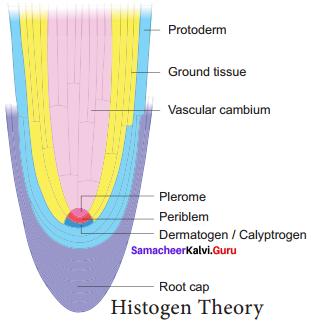
Korper Kappe Theory: Korper kappe theory is proposed by Schuepp. There are two zones in root apex – Korper and Kappe.
- Korper zone forms the body.
- Kappe zone forms The cap.
This theory is equivalent to tunica corpus theory of shoot apex.The two divisions are distinguished by the type of T (also called Y divisions). Korper is characterised by inverted T division and kappe by straight T divisions.
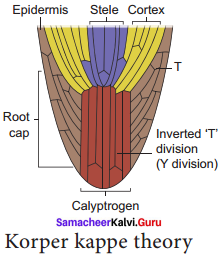
Quiescent Centre Concept: Quiescent centre concept was proposed by Clowes (1961) to explain root apical meristem activity. These centre is located between root cap and differentiating cells of the roots. The apparently inactive region of cells in root promeristem is called quiescent centre. It is the site of hormone synthesis and also the ultimate source of all meristematic cells of the meristem.
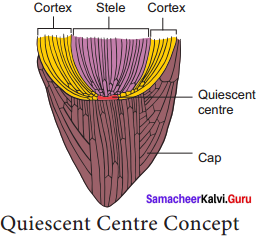
Question 2.
Describe the structure and function of different kinds of parenchyma tissues?
Answer:
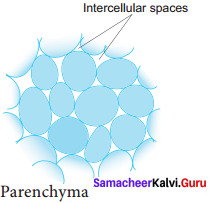
Parenchyma is generally present in all organs of the plant. It forms the ground tissue in a plant. Parenchyma is a living tissue and made up of thin walled cells. The cell wall is made up of cellulose. Parenchyma cells may be oval, polyhedral, cylindrical, irregular, elongated or armed. Parenchyma tissue normally has prominent intercellular spaces. Parenchyma may store various types of materials like, water, air, ergastic substances. It is usually colourless. The turgid parenchyma cells help in giving rigidity to the plant body. Partial conduction of water is also maintained through parenchymatous cells. Occsionaliy Parenchyma cells which store resin, tannins, crystals of calcium carbonate, calcium oxalate are called idioblasts. Parenchyma is of different types and some of them are discussed as follows. Types of paranchyma:
(i) Aerenchyma: Parenchyma which contains air in its intercellular spaces. It helps in aeration and buoyancy. eg: Nymphae and Hydrilia.
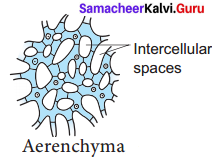
(ii) Storage Parenchyma: parenchyma stores food materials. eg: Root and stem tubers.
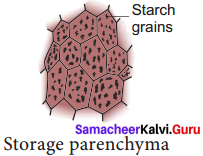
(iii) Stellate Parenchyma: Star shaped parenchyma. eg: Petioles of Banana and Canna.
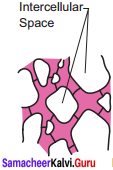
(iv) Chlorenchyma: Parenchyma cells with chlorophyll. Function is photosynthesis, eg: Mesophyll of leaves.
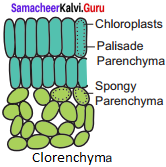
(v) Prosenchyma: parenchyma cells became elongated, pointed and slightly thick walled. It provides mechanical support.
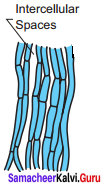
Question 3.
Describe the types of tracheids with diagram.
Answer:
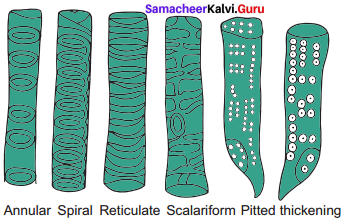
Types of secondary wall thickenings in tracheids and vessels:
Tracheids are dead, lignified and elongated cells with tapering ends. Its lumen is broader than that of fibres. In cross section, the tracheids are polygonal. There are different types of cell wall thickenings due to the deposition of secondary wall substances. They are annular (ring like), spiral (spring like), scalariform (ladder like) reticulate (net like) and pitted (uniformly thick except at pits). Tracheids are imperforated cells with bordered pits on their side walls. Only through this conduction takes place in Gymnosperms. They are arranged one above the other. Tracheids are chief water conducting elements in Gymnosperms and Pteridophytes. They also offer mechanical support to the plants.
Question 4.
Compare the different types of plant tissues.
Answer:
The different types of plant tissues:
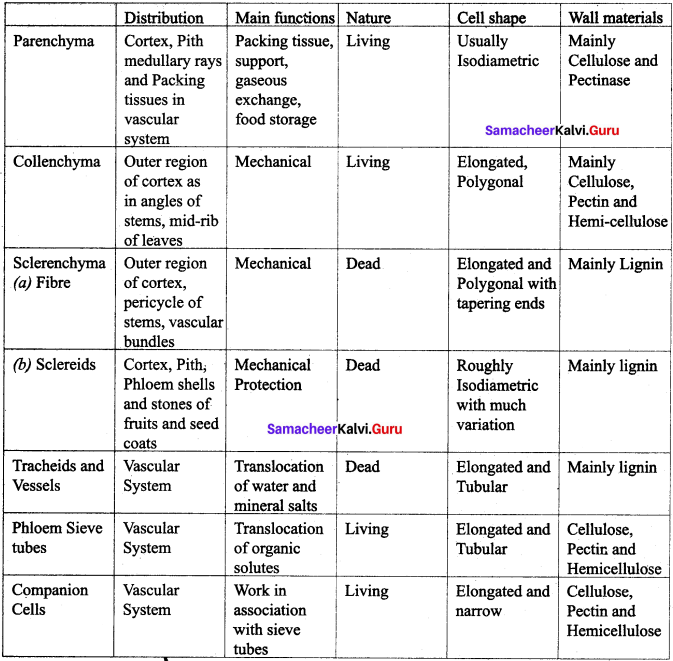
Question 5.
Compare the vascular tissues of plant.
Answer:
The vascular tissues of plant:
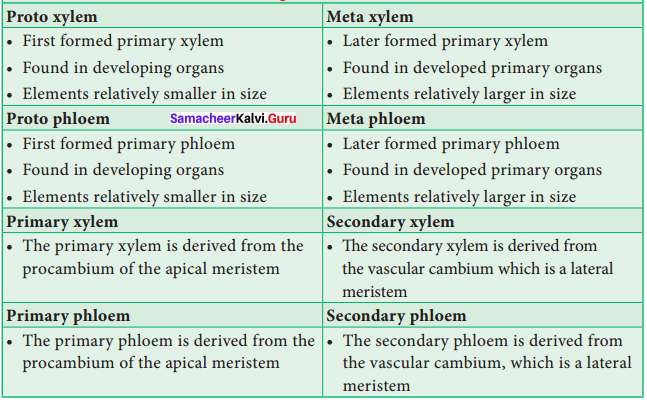
Question 6.
Draw and label the various parts of T.S. of dicot root.
Answer:
Draw and label the various parts of T.S. of dicot root:
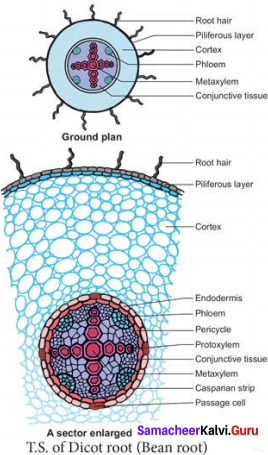
Question 7.
Explain in detail about the vascular bundles of monocot stem.
Answer:
1. Vascular bundles: Vascular bundles are scattered (atactostele) in the parenchyma ground tissue. Each vascular bundle is surrounded by a sheath of sclerenehymatous fibres called bundle sheath. The vascular bundles are conjoint, collateral, endarch and closed. Vascular bundles are numerous, small and closely arranged in the peripheral portion. Towards the centre, the bundles are comparatively large in size and loosely arranged. Vascular bundles are skull or oval shaped.
2. Phloem: The phloem in the monocot stem consists of sieve tubes and companion cells. Phloem parenchyma and phloem fibres are absent. It can be distinguished into an outer crushed protophloem and an inner metaphloem.
3. Xylem: Xylem vessels are arranged in the form of ‘Y’ the two metaxylem vessels at the base. In a mature bundle, the lowest protowylem disintegrates and forms a cavity known as protoxylem lacuna.
Question 8.
Draw and label the various parts of monocot stem.
Answer:
The various parts of monocot stem:
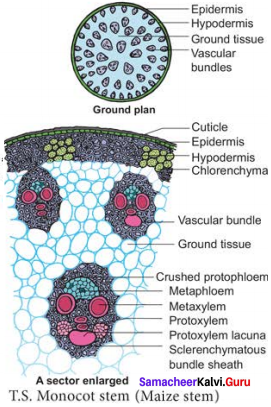
Question 9.
Explain the various parts of sunflower leaf with neat diagram.
Answer:
1. Anatomy of a Dicot Leaf – sunflower Leaf: Internal structure of dicotyledonous leaves reveal epidermis, mesophyll and vascular tissues.
2. Epidermis: This leaf is generally dorsiventral. It has upper and lower epidermis. The epidermis is usually made up of a single layer of cells that are closely packed. The cuticle on the upper epidermis is thicker than that of lower epidermis. The minute opening found on the epidermis are called stomata. Stomata are more in number on the lower epidermis than on the upper epidermis.
A stomata is surrounded by a pair of bean shaped cells are called guard cells. Each stoma internally opens into an air chamber. These guard cells contain chlotroplasts. The main function of epidermis is to give protection to the inner tissue called mesospyll. The cuticle helps to check transpiration. Stomata are used for transpiration and gas exchange.
3. Mesophyll: The entire tissue between the upper and lower epidermis is called mesophyll (GK meso = in the middle, phyllome = leaf). There are two regions in the mesophyll. They are palisade parenchyma and spongy parenchyma. Palisade parenchyma cells are seen beneath the upper epidermis. It consists of vertically elongated cylindrical cells in one or more layers. These are compactly arranged and are generally without intercellular spaces. Palisade parenchyma cells contain more chloroplasts than the spongy parenchyma cells.
The function of palisade parenchyma is photosynthesis. Spongy parenchyma lies below the palsied parenchyma. Spongy cells are irregularly shaped. These cells are very loosly arranged with numerous airspaces. As compared to palisade cells, the spongy cells contain number of chloroplasts. Spongy cells facilitate the exchange of gases with the help of air spaces. The air space that is found next to the stomata is called respiratory cavity or substomatal cavity. Å
4. Vascular tissue: Vascular tissue are present in the veins of leaf. Vascular bundles are conjoint collateral and closed. Xylem is present towards the upper epidermis, while the phloem towards the lower epidermis. Vascular bundles are surrounded by a compact layer by a parenchymatous cells called bundle sheath or border parenchyma.
Xylem consists of metaxylem and protoxylem elements. Protoxylem is present towards the upper epidermis, while the phloem consists of sieve tubes, companion cells and phloem parenchyma. Phloem fibres are absent. Xylem sonsists of vessels and xylem parenchyma. Tracheids and xylem fibres are absent.
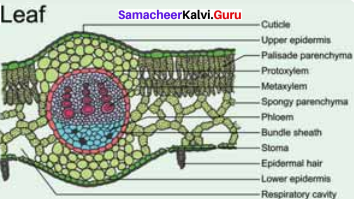
Solution To Activity
Text Book Page No. 10
Question 1.
Cell lab: Students prepare the slide and identify the different types tissues.
Answer:
Preparing a slide of plant tissue.
Objective:
- Using hand cutting method to make thin slice of dicot root.
- To make slide and stain of plant sample.
- To observe the plant sample under microscope.
Materials:
- A young dicot root
- Compound microscope
- Slide
- Cover slip
- Eosin stain
Method:
- Place 2 cm of young dicot root on a glass slide or plate.
- Cut thin slices of the root through the region of maturation.
- Stain it with Eosin.
- Fix one or two of the sections in a slide and put a cover slip.
- To observe the sample under a compound microscope and record the parts of the sample.
Believing that the Samacheer Kalvi 11th Biology Book Solutions Questions and Answers learning resource will definitely guide you at the time of preparation. For more details about Tamilnadu State 11th Bio Botany Chapter 9 Tissue and Tissue System textbook solutions, ask us in the below comments and we’ll revert back to you asap.